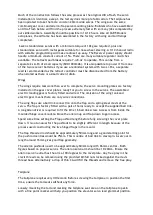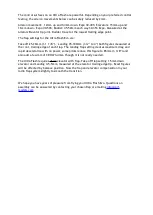
Much of the construction follows the same process as the original Ultra Flash, the servo
installation is identical, except, the factory does more pre fabrication. The tailplane has
been updated to take the more common 20mm wide servos. The wings use the same
combined gear cover and aileron/flap servo mounting plate. Builders who have assembled
an Ultra Flash before will find the process extremely fast with so many jobs completed by
our skilled workers. Assembly should be possible in 10-12 hours. Like all CARF-Models
aeroplanes, the airframe has been assembled in the factory with wing and tail fixings
completed.
Seven standard size servos with a minimum torque of 10kg are required, plus one
standard size servo with metal gears suitable for nose wheel steering. A 9-10 channel radio
with suitable programming will make radio set up easy. The Receiver power supply should
handle a minimum constant currant of 5A. There are many suitable regulator /switches
available. The retracts and brakes require 7.4-8.4v to operate. This can be from a
separate 2s Li-Po of small capacity (800-1000mAh). It is also possible to power it from one
of the two receiver batteries if you use a redundant system with two Li-Pos, a separate
lead is recommended as the retract controller must be disconnected from the battery
when stored as there is a small current drain.
Wings
The wings require less work than ever to complete, the servo mounting plates are factory
installed on the gear cover plates, ready for you to screw in the servos. The assembled
electric landing gear is factory fitted and wired. The omission of the wing tank and
electric gear means there are only wire connections.
The wing flaps use a ball link connection onto the flap and a spring steel clevis at the
servo. The flap is factory fitted with a pair of horns ready to accept the supplied ball link.
A long Allen driver is required to fit the M3 x 16 ball link screw. Access is from inside the
moulded hinge cover knuckle. Move the aileron up and flap down to gain access.
Spend some time setting the Flap pushrod length before fully screwing the cover plate
down. It is not unusual for the pushrods to be slightly different in length because of the
process used constructing the live hinged flaps in the mould.
The flap threaded rod should be approximately 50mm long and a good starting point for
the push rod centres would be 75mm. This is centre of ball link to clevis pin. A servo arm
length around 16mm gives good flap geometry.
The aileron pushrods need to be approximately 60mm long with 86mm centres. Both
figures based on popular servos. The aileron servo arm should be 19-20mm. Ensure the
aileron servo neutral has the arm at 90 degrees to the coverplate. Any free play in the
clevis thread can be removed using the provided M3 full nuts locked against the clevis
thread boss. Alternatively a drop of thin CA will fill the threads and remove the free play.
Tailplane
The tailplane requires very little work. Before screwing the tailplane in position the first
time, ensure the tail seats without any force.
Loosely mounting the tail and marking the tailplane seat area on the tailplane top skin
with a fine point marker will help you position the elevator servo lead grommet position.























